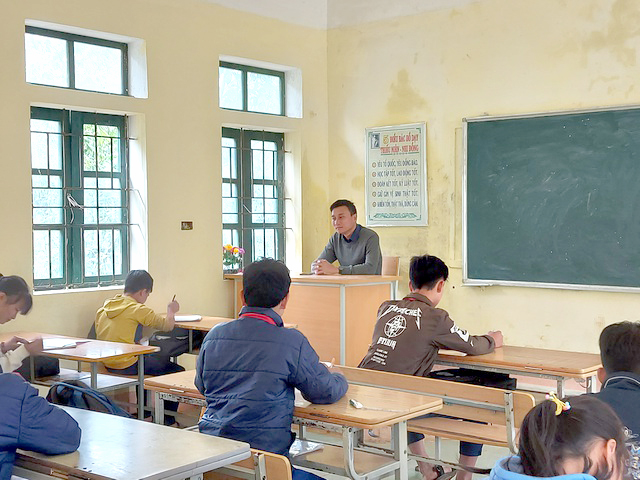 Society
Society

Kind-hearted teachers have to cross dangerous roads, battle severe weather and cope with poor living conditions with no electricity or water in a remote part of Thanh Hóa Province.

|
| Teacher Trần Ngọc Hải teaches students of Cao Sơn School in Lũng Cao Village. — Photo dantri.com.vn |
Nguyễn Thùy
THANH HÓA — Kind-hearted teachers have to cross dangerous roads, battle severe weather and cope with poor living conditions with no electricity or water in a remote part of central Thanh Hóa Province.
Every week, male teachers traverse a 15km pass with a sheer cliff on one side and an abyss on the other to reach Lũng Cao Commune on the slopes of Cao Sơn Peak – nearly 1,500m above sea level.
Lũng Cao Commune is considered the poorest commune in Bá Thước District.
Cao Sơn (high mountain) is surrounded by towering peaks and is almost constantly whipped by a cold, foggy wind.
Conditions at Cao Sơn School are extremely harsh, and there has not been a female teacher at the school since it was founded.
Because of the lack of basic necessities like electricity and clean water, along with the tricky transportation issue, only male teachers have ever taught in Cao Sơn.
One of the main reasons for women is the problems it would cause for family life once they came to work here.
Nguyễn Thế Tài, the school principal, cheerfully said: “There are dirt roads to the commune, but for several years now it's taken half a day by foot to reach Cao Sơn Peak.”
Lũng Cao Village still has no clean water or access to the national grid.
In Cao Sơn, only 30 per cent of inhabitants have access to electricity. Small hydro-powered turbines have been set up in streams to offer a glimmer of light.
But these hardships have failed to deter a hardy band of teachers who have become attached to the school over the past 10 years.
The school has 116 students and 13 teachers.
According to the principal, district authorities planned to close the school last year but decided against the idea because the alternative for many local children was located far away at the foot of the mountain.
The teachers still have to make that journey down the mountain at weekends to stock up on essentials such as sesame salt, peanuts and dried fish for their daily meals.
They live in temporary wooden rooms and the temperatures drop to 1-2 degrees Celsius during winter, and the hottest summer's day is only around 20 degree Celsius.
In winter, the cold cuts like a knife, accompanied by the frost, and the water freezes overnight. In the early morning, to boil a kettle of water takes more than an hour.
“There is no electricity, it’s foggy in winter, and we don't have enough daylight," said teacher Trần Ngọc Hải.
“We have to speak a lot because the students can't see the words on the board or in their books."
From early winter to the end of spring, teachers in Cao Sơn have to light a fire every day to keep the students warm.
Here, the children lack clothes and shoes.
When winter arrives, they cower, shaking and speechless, and their lips turn purple.
Every time the teachers go down the mountain, they collect old clothes and slippers for the students.
On rainy days, teachers and students sit in a corner because the classrooms all leak.
If life sounds difficult for the teachers in Cao Sơn, their colleagues at Lâm Phú School in Nà Đang Village, Lang Chánh District, about 130km from Thanh Hoa City, also have a tough job.
The school has only three teachers and three classrooms, each 10sq.m.
Teacher Lương Văn Xuân has taught in Nà Đang for eight years out of his 30-year career.
His house is only 12km from the school but he stays there during the week to encourage his students not to quit their lessons.
“Each year, I have to go to students' homes dozens of times to encourage them to return to class. On occasions such as after Tết, summer holidays or on cold and rainy days, the children don’t come to class anymore.“
“We are forced to stay in school to stop the children from dropping out,” said Xuân. — VNS




